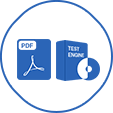A safe password must adhere to security best practices, including sufficient length, complexity, and resistance to common attacks (e.g., brute force, dictionary attacks). Let’s evaluate each option:
Option A ("Monday@123"): This password is weak because it combines a common word ("Monday") with a simple number and symbol pattern. It is vulnerable to dictionary attacks and does not meet complexity requirements (e.g., mixed case, special characters, and randomness).
Option B ("abcdef"): This is a sequence of letters with no numbers, special characters, or uppercase letters. It is extremely weak and easily guessable, making it unsafe.
Option C ("Sq0Jh819%ak"): This password is considered safe because it is at least 10 characters long, includes a mix of uppercase letters (S, J, H), lowercase letters (q, h, a, k), numbers (0, 8, 9, 1), and a special character (%). It lacks predictable patterns and meets modern password policy standards (e.g., NIST SP 800-63B recommends at least 8 characters with complexity).
Option D ("1234567890"): This is a simple numeric sequence, highly predictable, and vulnerable to brute-force attacks, making it unsafe.
The correct answer is C, as it aligns with secure password creation guidelines, a key topic in the CAP syllabus under "Authentication Security" and "Secure Coding Practices."References: SecOps Group CAP Documents - "Password Management," "Authentication Security," and "OWASP Secure Coding Guidelines" sections.








